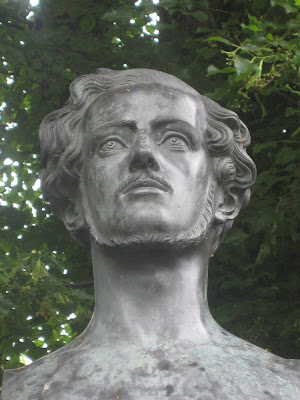 Due to his talents and his early death there has always been an aura of romance surrounding the name of Prince Gustaf, the second of five children of King Oscar I and Queen Josephina. He was born on 18 June 1827 at Haga Palace just outside Stockholm, where his bust (pictured above) can be found nearby. The choice of the name Gustaf, which was strongly associated with the deposed Holstein-Gottorp dynasty, was quite unexpected.
Due to his talents and his early death there has always been an aura of romance surrounding the name of Prince Gustaf, the second of five children of King Oscar I and Queen Josephina. He was born on 18 June 1827 at Haga Palace just outside Stockholm, where his bust (pictured above) can be found nearby. The choice of the name Gustaf, which was strongly associated with the deposed Holstein-Gottorp dynasty, was quite unexpected.Four of the five children of Oscar I and Josephina shared their parents’ artistic gifts. Prince Gustaf was a talented composer and that is how he is remembered today, as “Sångarprinsen” (the Singer Prince). Some of his songs are still popular in Sweden today, the most well-known being “Sjung om studentens lyckliga dag”. It is always sung by students when graduating – perhaps with particular fervour in Uppsala, where the Prince himself, who was also Duke of Uplandia, studied. “Glad såsom fågeln” is another of his light, happy songs. In a more sombre mood, the Prince in his early twenties wrote a funeral march, dedicating it “to myself”. It was not long before it was to be heard.
In 1851 Prince Gustaf became the owner of Stjernsund Palace near Askersund, which his grandfather Carl XIV Johan had bought as a place to rest on his travels between his two capitals. At the nearby manor Boo lived Baron Hugo Hamilton, head of the royal theatre, and Prince Gustaf fell in love with the Baron’s pretty, 17-year-old daughter Josephine. It has been claimed that the Prince intended to renounce his rights of succession to be able to marry Josephine, but no proof has been found for this.
There was something melancholic, something restless, something fragile about Prince Gustaf, whose health was never strong. In the summer of 1852 he travelled to Germany with his parents, sister Eugénie and brother August, but on the homebound journey he fell gravely ill aboard the ship sailing for Christiania. At the time it was said to be typhus, but more likely it was tuberculosis.
On arriving in the Norwegian capital, Prince Gustaf was carried to the newly completed Royal Palace where he died on 24 September, aged 25. With the exception of his great-nephew King Haakon VII he is the only royal to die at the Palace. His death nearly crushed Princess Eugénie, who had a breakdown she never really recovered from.
His elder brother Carl’s only son was born later that autumn, but died in infancy, leaving the succession to Oscar I’s third son. One can only guess at what sort of king Gustaf would have been. As a young man he was certainly no democrat, opposing the freedom of the press and democratic elections. We can only speculate on whether the history of Sweden and Norway would have taken a different turn if Carl XV had been succeeded by Gustaf V rather than Oscar II in 1872.





No comments:
Post a Comment
Comments are welcome, but should be signed - preferably by a name, but an initial or a nick will also be accepted. Advertisements are not allowed. COMMENTS WHICH DO NOT COMPLY WITH THESE RULES WILL NOT BE PUBLISHED.